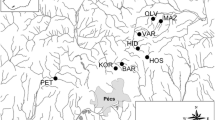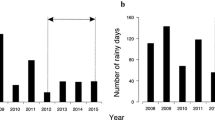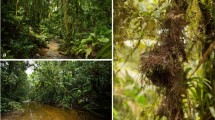Abstract
In odonates, the emergence behaviour and finding suitable substrates for successful molting may influence the next generation and ultimately can determine the survival of the entire population. Understanding emergence behavior of endangered species and those granted special conservation status is particularly important. Despite this, little is known about the life history and emergence behaviour of Cordulegaster heros, a characteristic inhabitant of headwater streams. We hypothesised that the taxonomic composition and structure of the vegetation significantly affect the travel distance to the emergence site and the substrate choice. Two stream sections with different riparian zone vegetation were surveyed for exuviae in the emergence periods in two consecutive years, supported with detailed vegetation mapping. Significant differences were found between the vegetation characteristics at the two sites and differences were also found between emergences in edge zones within a site, indicating that the importance of vegetation structure operates within the scale of sites as well as between sites. At the site with more diverse vegetation, smaller horizontal but higher vertical travel distances and more varied emergence substrate choice were found. Habitat composition and complexity appears to determine the emergence behaviour of C. heros, so for the successful conservation of this species we recommend choosing appropriate forest management regimes and even maintaining riparian forests in near-pristine condition.





Similar content being viewed by others
References
Askew RR (2004) The dragonflies of Europe (revised edition). Harley Books, Colchester
Bedjanic M, Salamun A (2003) Large golden-ringed dragonfly Cordulegaster heros Theischinger 1979, new for the fauna of Italy (Odonata: Cordulegastridae). Nat Slov 5(2):19–29
Bennett S, Mill PJ (1993) Larval development and emergence in Phyrrhosoma nymphula (Sulzer) (Zygoptera: Coenagrionidae). Odonatologica 22:133–145
Blaškovič T, Bulánková E, Šíbl J (1979) First record of Cordulegaster heros ssp. heros Theischinger, 1979 (Cordulegastridae, Odonata) from Slovakia. Biol Bratisl 58(2):293–294
Boda R, Gy Rozner, Czirok A, Szivák I, Csabai Z (2011) New data on the distribution of Cordulegaster heros Theischinger, 1979 in Mecsek mountains and its surroundings. Acta Biol Debr Oecol Hung 26:21–28
Boudot JP (2010) Cordulegaster heros. In: IUCN 2013. IUCN red list of threatened species. Version 2013.2. <www.iucnredlist.org>. Downloaded on 22 January 2014
Clausnitzer V, Kalkman VJ, Ram M, Ben Collen, Baillie JME, Bedjanic M, Darwall WRT, Dijkstra KDB, Dow R, Hawking J, Karube H, Malikova E, Paulson D, Schütte K, Suhling F, Villanueva RJ, Ellenrieder N, Wilson K (2009) Odonata enter the biodiversity crisis debate: the first global assessment of an insect group. Biol Conserv 142:1864–1869
Corbet PS (1957) The life-history of the emperor dragonfly Anax imperator Leach (Odonata: Aeshnidae). J Anim Ecol 26:1–69
Corbet PS (1983) A biology of dragonflies. E. W. Classey Ltd., Faringdon
Corbet PS (1999) Dragonflies: behaviour and ecology of Odonata. Harley Books, Colchester
Dévai Gy (1979) Ritka hegyiszitakötő—Cordulegaster heros Theischinger, 1979 [Balkan Goldenring—Cordulegaster heros Theischinger, 1979]. In: Haraszthy L (ed) Natura 2000 fajok és élőhelyek Magyarországon [Natura 2000 Species and habitats in Hungary]. Csákvár, Pro Vértes Természetvédelmi Közalapítvány, pp 181–184
EC (1992) Council directive 92/43/EEC of 21 May 1992 on the conservation of natural habitats and of wild fauna and flora
Falck J, Johansson F (2000) Patterns in size, sex ratio and time at emergence in s South Swedish population of Sympetrum sanguineum (Odonata). Aquat Insect 22(4):311–317
Farkas A, Jakab T, Gy Dévai (2009) Folyami szitakötők (Odonata: Gomphidae) populációinak exuviumokon alapuló felmérése a Tisza vásárosnaményi szakaszán. [Assessment of riverine dragonfly population (Odonata:Gomphidae) on the basis of exuviae on the reach of the River Tisza at Vásárosnamény. (in Hungarian with English abstract)]. Acta Biol Debr Oecol Hung 20:65–78
Farkas A, Móra A, Gy Dévai (2012) A Gomphus flavipes és a G. vulgatissimus (Odonata: Gomphidae) kirepüléskori mortalitása a Dunán [Mortality during emergence in Gomphus flavipes and G. vulgatissimus (Odonata: Gomphidae) along the Danube. (in Hungarian with English abstract)]. Acta Biol Debr Oecol Hung 28:65–82
Farkas A, Jakab T, Müller O, Móra A, Lajter I, Gy Dévai (2013) Sex ratio in Gomphidae (Odonata) at emergence: is there a relationship with water temperature? Int J Odonatol 16(4):279–287
Gerken B, Steinberg K (1999) Die exuvien europäischen Libellen (Insecta, Odonata). Arnika and Eisvogel, Höxter and Jena
Horváth G (2012) Assessment of riverine dragonflies (Odonata: Gomphidae) and the emergence behaviour of their larvae based on exuviae data on the river Tisza in Szeged. Tiscia 39:9–15
Jakob C, Suhling F (1999) Risky times? Mortality during emergence in two species of dragonflies (Odonata: Gomphidae, Libellulidae). Aquat Insect 21(1):1–10
Kalkman VJ, Boudot J-P, Bernard R, Conze K-J, De Knijf G, Dyatlova E, Ferreira S, Jović M, Ott J, Riservato E, Sahlén G (2010) European red list of dragonflies. IUCN and Publications Office of the European Union, Luxembourg
Kormondy EJ, Gower JL (1999) Life history variation in an association of Odonata. Ecology 46(6):882–886
Lang C, Müller H, Waringer JA (2001) Larval habitats and longitudinal distribution patterns of Cordulegaster heros Theischinger and C. bidentata Sélys in an Austrian forest stream (Anisoptera: Cordulegastridae). Odonatologica 30(4):395–409
Liebelt R, Lohr M, Beinlich B (2011) Zur Verbreitung der Gestreiften und der zweigetreiften Quelljungfer (Cordulegaster bidentata und C. boltonii) im Kreis Höxter (Insecta, Odonata, Cordulegsteridae). Beitr Naturk Egge u Weser 22:3–18
Lubertazzi MAA, Ginsberg HS (2009) Persistence of dragonfly exuviae on vegetation and rock substrates. Northeast Nat 16(1):141–147
Miller PL (1964) Notes on Ictinogomphus ferox Rambur (Odonata: Gomphidae). Entomologist 97:52–66
Podani J (2000) SYN-TAX 2000—computer programs for data analysis in ecology and systematics. User’s manual, Scientia Kiadó, Budapest
Rozner Gy, Ferincz Á, Miókovics E (2012) Data to the distribution of Golden Ringed Dragonfly (Cordulegaster bidentata Sélys, 1843) and Large Golden Ringed Dragonfly (Cordulegaster heros Theischinger, 1979) in Bakony Mountains. Term Véd Közl 18:447–455
SPSS Inc. (2011) IBM SPSS statistics Version 19. www.spss.com
Staufer M, Holuša O (2010) First record of Cordulegaster heros ssp. heros Theischinger in the Czech Republic and notes on Cordulegaster species occurrence in the southern part of Moravia (Odonata: Cordulegastridae). Libellula 29(3/4): 197–204
Suhling F, Müller O (1996) Die Flussjungfern Europas (Gomphidae). In: Die Neue Brehm-Bücherei 628. Westarp and Spektrum, Magdeburg and Heidelberg
Ter Braak CJF, Smilauer P (2002) CANOCO Reference maual and CanoDraw for windows user’s guide: Software for canonical community ordination (ver. 4.5). Biometris, Wageningen and Ceské Budejovice
Theischinger G (1979) Cordulegaster heros sp. nov. und Cordulegaster heros pelionensis ssp. nov., zwei neue Taxa des Cordulegaster boltoni (Donovan)—Komplexes aus Europa (Anisoptera: Cordulegastridae). Odonatologica 8:23–38
Tóth S (2006) The occurence of the rare Cordulegaster heros in the Zselic Hill (South Transdanubian Region). Nat Som 9:141–144
van Tol J (ed.) (2013) Odonata. Fauna Europaea version 2.6. http://www.faunaeur.org. Last visited: 21 November 2013
VM 2012. 100/2012. (IX. 28.) VM rendelete a védett és a fokozottan védett növény- és állatfajokról, a fokozottan védett barlangok köréről, valamint az Európai Közösségben természetvédelmi szempontból jelentős növény- és állatfajok közzétételéről szóló 13/2001. (V. 9.) KöM rendelet és a növényvédelmi tevékenységről szóló 43/2010. (IV. 23.) FVM rendelet módosításáról [Decree of the Ministry of Environmental Protection about the protected and strictly protected plant and animal species, the strictly protected caves, and publishing the plant and animal species of nature conservation importance in the European Commission]. Magyar Közlöny 2012(128): 20903–21019. (in Hungarian)
Weihrauch F (2003) Studies on the emergence of Cordulegaster b. boltonii at a forest rivulet in Lower Bavaria (Odonata: Cordulegastridae). Libellula Suppl 4: 3–18
Acknowledgments
Authors' thanks are due to the students (Gréta Bognár, Dániel Németh) of University of Pécs for their extensive help during field works. We thank to Thomas G. Horvath (University of Koblenz-Landau) for providing language improvements. Thanks also for the valuable and constructive comments of two anonymous reviewers.
Author information
Authors and Affiliations
Corresponding author
Electronic supplementary material
Below is the link to the electronic supplementary material.
Rights and permissions
About this article
Cite this article
Boda, R., Bereczki, C., Ortmann-Ajkai, A. et al. Emergence behaviour of the red listed Balkan Goldenring (Cordulegaster heros Theischinger, 1979) in Hungarian upstreams: vegetation structure affects the last steps of the larvae. J Insect Conserv 19, 547–557 (2015). https://doi.org/10.1007/s10841-015-9776-3
Received:
Accepted:
Published:
Issue Date:
DOI: https://doi.org/10.1007/s10841-015-9776-3




